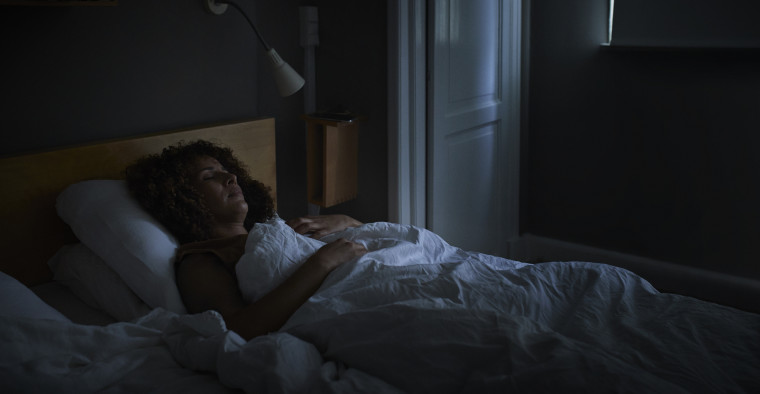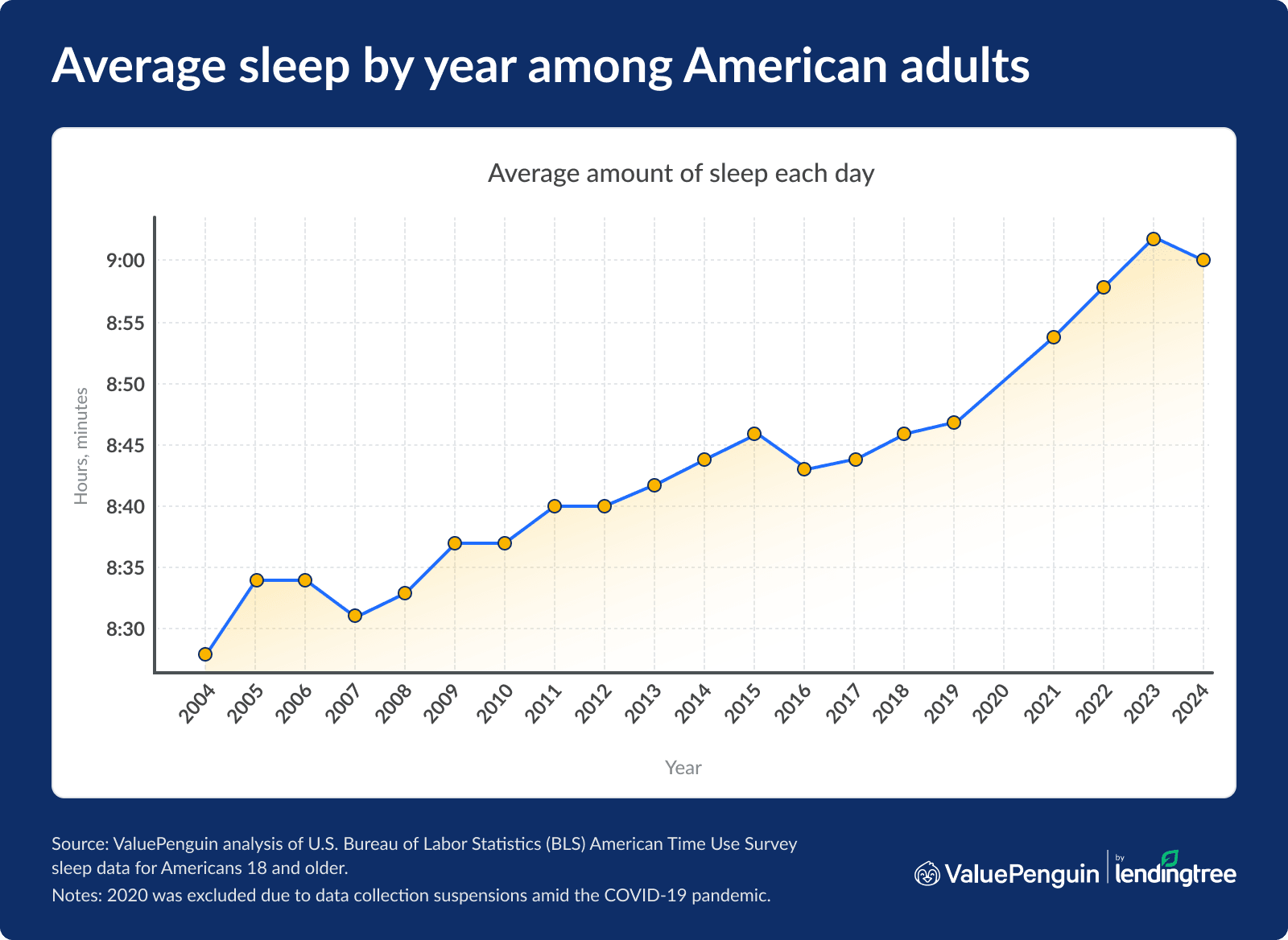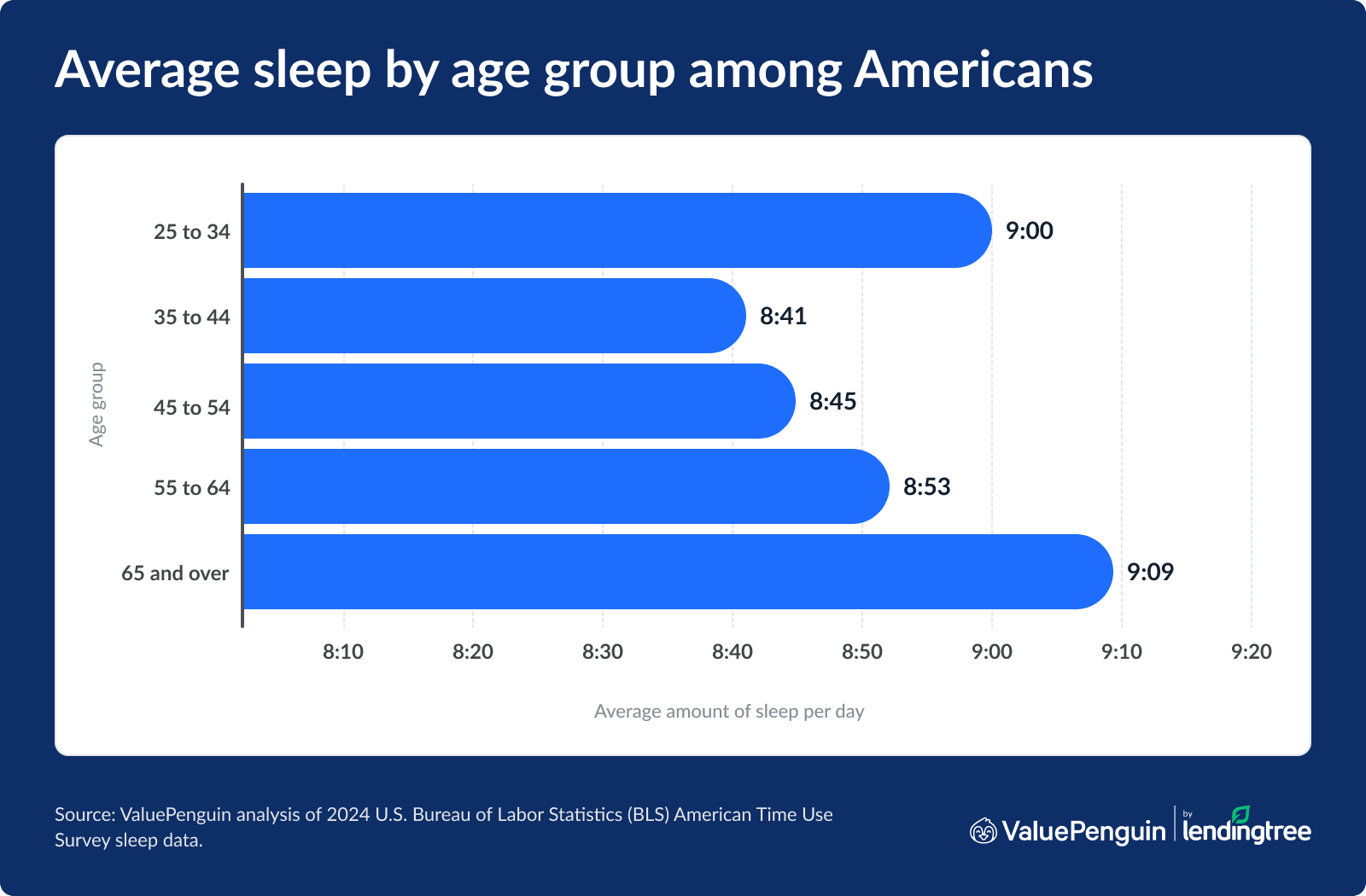Health Insurance
Sleep Is In: American Adults Now Average 9 Hours a Day

The hustle is out, and the pillow is in.
Americans are snoozing longer than ever, according to a ValuePenguin study, at a daily average of nine hours even, among adults 18 and older. But how much sleep you get depends on more than when you crawl into bed: Your age and gender, where you live and whether it’s a weekday or weekend all influence daily averages.
Here’s a closer look.
On this page
Key findings
- Americans are getting more sleep than ever. In 2004, Americans 18 and older slept an average of eight hours and 28 minutes a day. By 2024, that figure had increased to nine hours even. That’s an extra 195.2 hours a year, or more than eight days of added sleep.
- Women squeeze in 10 more minutes of sleep than men each day. Women 18 and older sleep an average of nine hours and four minutes a day, while men sleep an average of eight hours and 54 minutes. That means women slept an extra 61.0 hours in 2024, or about two-and-a-half days more.
- Older Americans get the most sleep. People 65 and older sleep an average of nine hours and nine minutes a day — the highest among all age groups. Those 25 to 34 sleep an average of nine hours even — the only other group at nine hours or more. Meanwhile, Americans 35 to 44 sleep the least, at an average of eight hours and 41 minutes.
- Not surprisingly, people tend to catch up on sleep over the weekend. On those days, adults sleep an average of nine hours and 31 minutes. Comparatively, they get eight hours and 46 minutes of sleep on weekdays.
- Where you live matters for sleep. Nebraska residents, regardless of age, sleep the most, averaging nine hours and 56 minutes a day. Arkansas (nine hours and 45 minutes) and Hawaii (nine hours and 26 minutes) follow. Conversely, North Dakota residents average just eight hours and 22 minutes, below Wisconsin (eight hours and 26 minutes) and Vermont (eight hours and 28 minutes).
Americans sleeping more
Americans are getting their sleep in. In 2004, Americans 18 and older slept eight hours and 28 minutes a day, which includes naps and periods of sleeplessness. That figure rose to nine hours and two minutes in 2023, surpassing the nine-hour mark for the first time. By 2024 (the latest available year), Americans slept for nine hours even.

That’s an extra 195.2 hours a year, or more than eight days of added sleep, compared to 2004. (Our math factors in that 2004 and 2024 were leap years.)
One reason Americans could be sleeping more? The population is aging, with those 65 and older estimated to more than double over the next 40 years, according to the Urban Institute. That age group gets the most sleep on average, but more on that below. Additionally, changes in sleep-tracking technology (like smartwatches) may mean Americans are more knowledgeable about their sleep patterns than in the early 2000s.
According to ValuePenguin health insurance expert Talon Abernathy, more sleep is unquestionably good.
"Multiple studies have shown that getting less sleep over a long period significantly increases the risk of early death and several chronic diseases, including obesity, diabetes and hypertension," he says. "Getting less sleep can also have nasty short-run effects by making you more prone to less serious illnesses like the common cold. On the flipside, getting more sleep has been shown to improve moods, strengthen immune systems and boost activity levels."
Women, older Americans get most sleep
By gender, women get a little more shut-eye than men. Women 18 and older sleep an average of nine hours and four minutes a day — 10 minutes more than the average eight hours and 54 minutes a day that men sleep.
That means women slept an extra 61.0 hours in 2024 (remember, a leap year), or about two-and-a-half days more than men.
In 2004, men got just eight hours and 24 minutes of sleep, while women got eight hours and 32 minutes.
Avg. amount of sleep by year and gender
Year | Avg., men | Avg., women |
|---|---|---|
| 2004 | 8:24 | 8:32 |
| 2005 | 8:28 | 8:39 |
| 2006 | 8:29 | 8:39 |
| 2007 | 8:27 | 8:34 |
| 2008 | 8:30 | 8:36 |
| 2009 | 8:33 | 8:41 |
| 2010 | 8:31 | 8:43 |
| 2011 | 8:34 | 8:46 |
| 2012 | 8:31 | 8:49 |
| 2013 | 8:35 | 8:48 |
| 2014 | 8:37 | 8:51 |
| 2015 | 8:42 | 8:51 |
Source: ValuePenguin analysis of U.S. Bureau of Labor Statistics (BLS) American Time Use Survey sleep data for Americans 18 and older. Notes: 2020 was excluded due to data collection suspensions amid the COVID-19 pandemic.
Across each year analyzed, women have gotten more sleep than men. That difference was largest in 2012, when women got 18 more minutes of sleep than men — at eight hours and 49 minutes versus eight hours and 31 minutes.
Meanwhile, by age, adults 65 and older sleep an average of nine hours and nine minutes a day — the highest among this demographic.
Interestingly, the National Institute on Aging states that older adults don't need more sleep than younger adults. So why are they sleeping more?
"Many adults shed responsibilities that require getting up early as they age," Abernathy says. "That's especially true as you hit retirement age and your kids leave the house. But there may be another culprit. Research indicates that aging can make it more challenging to maintain uninterrupted sleep for extended periods. That could mean older adults compensate for choppy sleep patterns by sleeping longer overall, but in smaller chunks than younger age cohorts."

Following that, those 25 to 34 sleep an average of nine hours even. On the other hand, Americans 35 to 44 sleep the least, at an average of eight hours and 41 minutes.
Americans get more sleep on weekends
Perhaps unsurprisingly, weekends offer Americans a chance to catch up on sleep. (Note: The weekend data includes Saturdays and Sundays and the New Year’s Day, Easter, Memorial Day, Fourth of July, Labor Day, Thanksgiving Day and Christmas Day holidays.) On those days, adults sleep an average of nine hours and 31 minutes, compared to just eight hours and 46 minutes of sleep on weekdays. (Note: Weekday data includes Monday through Friday but excludes those major holidays.)
Avg. amount of sleep by year and day of the week
Year | Avg., weekdays | Avg., weekends |
|---|---|---|
| 2004 | 8:11 | 9:09 |
| 2005 | 8:18 | 9:12 |
| 2006 | 8:18 | 9:14 |
| 2007 | 8:14 | 9:09 |
| 2008 | 8:15 | 9:14 |
| 2009 | 8:21 | 9:16 |
| 2010 | 8:21 | 9:16 |
| 2011 | 8:25 | 9:16 |
| 2012 | 8:24 | 9:18 |
| 2013 | 8:27 | 9:15 |
| 2014 | 8:30 | 9:19 |
| 2015 | 8:33 | 9:18 |
Source: ValuePenguin analysis of U.S. BLS American Time Use Survey sleep data for Americans 18 and older. Notes: 2020 was excluded due to data collection suspensions amid the COVID-19 pandemic.
Looking back, the biggest difference in sleep patterns between weekends and weekdays was observed in 2008. Adults slept an average of eight hours and 15 minutes on weekdays, while they slept nine hours and 14 minutes on weekends — a difference of 59 minutes.
Nebraska residents sleep most
Sleep also varies by state. Regardless of age (this isn’t limited to those 18 and older), Nebraska residents sleep the most, averaging nine hours and 56 minutes of sleep a day.
Arkansas (nine hours and 45 minutes) ranks second, and Hawaii (nine hours and 26 minutes) ranks third.
Conversely, North Dakota residents sleep the least, averaging just eight hours and 22 minutes. Wisconsin (eight hours and 26 minutes) and Vermont (eight hours and 28 minutes) rank second and third, respectively.
Abernathy says this is likely to have an impact on health trends.
"We know that getting less sleep results in all sorts of health problems and conditions that can lead to serious medical issues down the line, such as diabetes and obesity," he says. "All else equal, states with worse sleep patterns should tend to have worse health outcomes than other areas of the country."
Full rankings: States where residents get the most/least amount of sleep
Rank | State | Avg. |
|---|---|---|
| 1 | Nebraska | 9:56 |
| 2 | Arkansas | 9:45 |
| 3 | Hawaii | 9:26 |
| 4 | Kentucky | 9:22 |
| 4 | Oregon | 9:22 |
| 6 | Louisiana | 9:16 |
| 7 | Mississippi | 9:14 |
| 8 | Illinois | 9:11 |
| 9 | Washington | 9:10 |
| 9 | Tennessee | 9:10 |
| 11 | Alabama | 9:09 |
| 12 | Utah | 9:08 |
Source: ValuePenguin analysis of 2024 U.S. BLS American Time Use Survey sleep data.
Improving sleep, and how it affects insurance: Top expert tips
While poor sleep may mean poor health, there’s some good news: The Affordable Care Act banned health insurance companies from raising rates or denying coverage based on preexisting conditions.
"That means you won't pay a higher monthly rate for coverage because of your sleep apnea," Abernathy says. "But life insurance companies don't have to follow these rules. That means you'll likely pay higher monthly rates or even get denied coverage if you have severe sleep apnea."
If you’re looking to improve your sleep habits, here are some things to keep in mind:
- See if your insurance company offers sleep incentives. "Because sleep apnea is linked to so many bad health outcomes, some health insurance plans now offer incentives and extra support to help you sleep better," Abernathy says. "For example, Anthem members can earn badges and rewards for participating in sleep improvement programs."
- Be consistent. "If you want to get more sleep and avoid higher insurance rates, consider getting serious about your 'sleep hygiene' by setting a consistent bedtime," he says. "Sleeping in on the weekends may be tempting, but waking up at the same time every day is essential for maintaining good sleep habits."
- Avoid caffeine in the afternoon, and limit alcohol intake in the evening. "Regular exercise can help you sleep better, but it's a good idea to wrap up a few hours before bedtime to avoid staying awake into the small hours of the morning," he says. "Try to limit screen time before you hit the hay, and maintain a quiet, dark and cool bedroom to ensure you fall asleep faster and wake up less frequently."
Methodology
ValuePenguin researchers analyzed U.S. Bureau of Labor Statistics (BLS) American Time Use Survey data from 2004 to 2024 to estimate the average daily sleep time of Americans. Sleep estimates include naps and spells of sleeplessness.
The BLS didn’t include 2020 due to data collection suspensions amid the COVID-19 pandemic.
Researchers filtered the national data by adults 18 and older, also using this for the gender and day demographics. The demographic look by age starts at 25.
To analyze sleep by state, we analyzed 2024 IPUMS microdata, which isn’t limited to adult-age residents.
